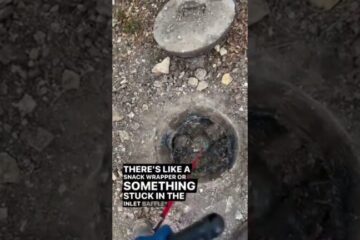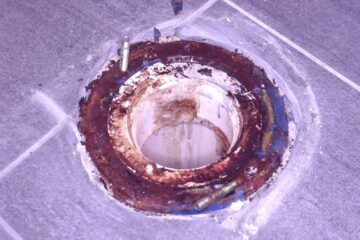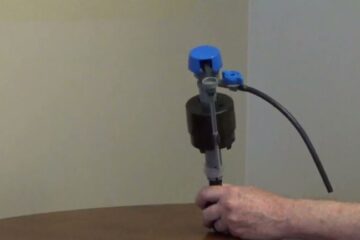Moen Kitchen Faucet Leaking
Are you tired of dealing with a leaky Moen kitchen faucet? Not only is it annoying to constantly hear that dripping sound, but it can also lead to wasted water and higher bills.
Fortunately, repairing your Moen kitchen faucet doesn’t have to be a daunting task. By following a few simple steps, you can easily fix the issue and say goodbye to leaks for good.
In this article, we’ll guide you through the process of:
- Diagnosing the issue
- Gathering the necessary tools and parts
- Disassembling the faucet
- Replacing the necessary parts
- Testing the faucet to ensure there are no leaks
With our step-by-step instructions and helpful tips, you’ll be able to tackle this repair project with confidence, even if you don’t have any prior plumbing experience.
So, grab your tools, and let’s get started on repairing your Moen kitchen faucet!
Diagnose the Issue
You’re feeling frustrated as water droplets continue to drip, drip, drip from your sink, and you need to figure out what’s causing the issue. The good news is that diagnosing a leaky Moen kitchen faucet isn’t rocket science.
Common causes of leaks include worn-out O-rings, damaged cartridges, and loose nuts or screws. You can start to troubleshoot by examining the faucet for visible signs of damage.
If the water drips from the spout when the faucet is turned off, the most likely culprit is a faulty cartridge. To replace it, you need to disassemble the faucet by removing the handle, bonnet, and cartridge.
Once you have the cartridge out, take it to a hardware store to find a replacement that matches your faucet’s model and size. Reassemble the faucet, turn the water supply back on, and test the faucet for leaks. If water comes out from the base of the faucet when the faucet is turned on, the problem may be with the O-rings. These small rubber rings create a tight seal that prevents water from leaking around the base of the faucet.
You can replace them by disassembling the faucet and removing the spout. Replace the O-rings with new ones, reassemble the faucet, and test it for leaks. Don’t forget to use the plumber’s grease to lubricate the O-rings before reassembling the faucet.
In conclusion, diagnosing a leaky Moen kitchen faucet requires a bit of patience and attention to detail. By following these troubleshooting steps, you can identify the most likely causes of leaks and fix them yourself.
Remember to turn off the water supply before you start, and to take your time to avoid damaging any parts. With a little bit of effort, you can say goodbye to leaks and enjoy a fully functional kitchen faucet once again.
Gather the Necessary Tools and Parts
To prepare for repairing your Moen kitchen faucet, you’ll need to gather the necessary tools and parts. When it comes to tools, you’ll need a pair of pliers, an adjustable wrench, and a screwdriver.
In terms of parts, it’ll depend on the specific issue with your faucet, but you may need a new cartridge, O-rings, or washers.
Tools Needed for the Repair
To successfully complete the repair, you’ll need a variety of tools that are readily available at most hardware stores. Here’s a list of the essential tools needed for the repair:
- Screwdrivers: You’ll need both a Phillips head and a flathead screwdriver to remove the faucet handle and other parts. Make sure your screwdrivers are in good condition, with no signs of wear and tear. A damaged tool can cause damage to your faucet, so it’s essential to ensure your tools are in top shape. Be sure to wear safety glasses to protect your eyes in case of a slip or a loosened screw.
- Pliers: You’ll need a pair of pliers to remove the retaining clip that holds the cartridge in place. Check the pliers’ jaws for signs of wear and make sure they grip tightly to avoid slipping while you’re working. Use insulated pliers to avoid electrical shocks if you’re working on an electrically powered faucet. Also, be careful not to over-tighten the pliers, as this can cause damage to the parts you’re working on.
By having these tools and ensuring they’re in good condition, you’ll be adequately equipped to repair your Moen kitchen faucet. Just remember to take the necessary safety precautions and maintain your tools to avoid any mishaps during the repair process.
Parts Needed for the Repair
If you’re experiencing a decrease in water pressure or irregular water flow, it may be time to replace the cartridge. This is one of the most common faucet issues that occur in Moen kitchen faucets, but fortunately, it can be fixed easily with a replacement part that costs around $20.
Before you start the repair, you’ll need to make sure you have the right part. To find the replacement cartridge for your Moen kitchen faucet, you’ll need to determine the model of your faucet. You can usually find this information on the manufacturer’s website or by contacting their customer service department.
Once you have the model number, you can order the replacement part online or purchase it from a home improvement store. It’s important to make sure you have the correct cartridge for your faucet model, as using the wrong one can cause further damage and leaks. In addition to the cartridge, you may also need other parts such as O-rings or a cartridge puller, depending on the specific repair needed.
Disassemble the Faucet
Ready to take apart your faucet like a pro? Let’s disassemble it step by step. First, turn off the water supply under the sink. Then, remove the handle by unscrewing the set screw with an Allen wrench. If the handle is stuck, use a handle puller to remove it. Next, remove the cap and cartridge by unscrewing them with pliers.
Once you have disassembled the faucet, it’s important to clean all the parts thoroughly. Use a soft-bristled toothbrush and a vinegar solution to clean any mineral buildup or debris from the cartridge, aerator, and other parts. Be careful not to damage any rubber or plastic parts during cleaning.
After cleaning, dry all parts thoroughly with a clean towel. When reassembling the faucet, make sure to follow the manufacturer’s instructions carefully. Lubricate the O-rings and other rubber parts with silicone grease before reassembling. Tighten all screws and connections carefully, but don’t overtighten.
Finally, turn the water supply back on and test the faucet for leaks. With these cleaning instructions and reassembly tips, your Moen kitchen faucet will be working like new in no time.
Replace the Necessary Parts
Now it’s time to swap out the pieces that need replacing, giving your trusty faucet a fresh start and a new lease on life. Before you jump into replacing any parts, make sure you’ve got the necessary tools on hand. You’ll need a pair of pliers, an adjustable wrench, and a screwdriver. Having these tools at the ready will make the process much smoother and ensure that you don’t damage any parts in the process.
When it comes to replacing parts, there are a few troubleshooting tips to keep in mind. If your faucet is leaking from the spout, the problem may be a worn-out cartridge. To replace the cartridge, turn off the water supply under the sink, remove the handle, and unscrew the cartridge. You can then insert the new cartridge and reassemble the faucet. If the leak is coming from the base of the faucet, the problem may be a worn-out O-ring. To replace the O-ring, remove the spout and replace the old O-ring with a new one.
Once you’ve identified the parts that need replacing and have the necessary tools on hand, it’s time to get to work. Follow the manufacturer’s instructions carefully to ensure that you install the new parts correctly. Take your time and be gentle to avoid causing any damage to the faucet. With a little patience and some elbow grease, you’ll have your Moen kitchen faucet working like new in no time.
Test the Faucet and Check for Leaks
After replacing the necessary parts, it’s time to test your trusty faucet and make sure that water flows smoothly without any dripping or spraying. Testing your faucet is critical to ensure that it doesn’t leak again. Common causes of leaks include worn-out O-rings, worn-out valve seats, or corroded cartridges. Prevention tips include regularly cleaning your faucet, avoiding using harsh chemicals, and calling a professional plumber to fix any leaks.
To test your faucet, turn on the water supply and let it run for a few minutes. Check that there are no leaks around the base of the faucet, the handles, or the spout. Make sure to check for any water spraying or dripping. If there are no leaks or drips, you’re good to go. If there are, use a wrench to tighten any loose parts or replace any worn-out components. Once you’re sure that your faucet is leak-free, you can enjoy your kitchen sink without worrying about water damage. Remember to keep up with regular maintenance to prevent future leaks.
A well-maintained faucet can last for years. Now, you can confidently say goodbye to leaks and enjoy your kitchen faucet’s full functionality.
FAQs
What are the most common causes of leaks in Moen kitchen faucets?
To identify leaks in your Moen kitchen faucet, check the spout, handles, and base for any visible water droplets or puddles. Leaks can be caused by worn-out O-rings, corroded valve seats, or loose connections.
Preventing future leaks requires regular maintenance, including cleaning and lubricating the faucet’s parts, replacing damaged components promptly, and tightening loose connections. Additionally, avoid using harsh chemicals or abrasive cleaning materials that can damage the faucet’s finish and lead to leaks.
By properly identifying and addressing leaks in your Moen kitchen faucet, you can prevent costly water damage and extend the life of your faucet.
How do I know if I need to replace the entire faucet or just certain parts?
When it comes to faucet replacement, it’s important to know whether you need to repair or replace certain parts or the entire faucet. If your faucet is leaking, the first step is to diagnose the problem. If the leak is coming from the base of the faucet, it may be a sign that the O-ring needs to be replaced. If the leak is coming from the spout, the problem may be a worn-out cartridge.
In some cases, it may be more cost-effective to replace certain parts rather than the entire faucet. However, if your faucet is outdated or damaged beyond repair, replacing the entire faucet may be necessary. Ultimately, the decision to repair or replace your faucet will depend on the severity of the problem, the age of the faucet, and your budget.
Can I use any type of replacement parts or do I need to use specific Moen parts?
As the old adage goes, “You get what you pay for.” When it comes to repairing your Moen kitchen faucet, it’s important to use the right replacement parts to ensure a lasting fix. While there may be generic alternatives available, using Moen replacement parts will provide the best fit and functionality for your faucet. Moen replacement parts are specifically designed to work with Moen faucets and are made with high-quality materials to withstand the wear and tear of daily use.
Using generic alternatives may save you money in the short term, but they may not provide the same level of durability and performance as the original parts. So, if you want to avoid future leaks and ensure your faucet is functioning at its best, stick with Moen replacement parts.
Is it safe for me to attempt to repair my Moen kitchen faucet on my own, or should I call a professional plumber?
When considering whether to attempt a DIY repair or call a professional plumber for your Moen kitchen faucet, safety concerns should be your top priority. While repairing your faucet on your own may seem like a cost-effective option, it can also be incredibly dangerous if you lack the necessary skills and experience. Any misstep during the repair process could lead to serious injuries or further damage to your faucet.
On the other hand, hiring a professional plumber ensures that the repair will be done safely and correctly. They have the necessary training and experience to handle any issues that may arise during the repair process.
Ultimately, the decision between DIY and professional repair depends on your skill level and comfort with handling plumbing repairs. However, if safety is a concern, it’s always best to leave it to the professionals.
How often should I expect to need to repair or replace parts in my Moen kitchen faucet?
You may be wondering how often you need to repair or replace parts in your Moen kitchen faucet. The frequency of repairs largely depends on the age and usage of the faucet, but as a general rule, you can expect to replace certain parts every 7-10 years. This includes the cartridge, which controls water flow, and the O-rings, which prevent leaks. However, with proper preventative maintenance tips, you can extend the lifespan of your faucet and reduce the need for repairs.
Regularly cleaning the aerator and handle, checking for leaks, and avoiding harsh chemicals can all help prevent damage to your faucet. Remember, an ounce of prevention is worth a pound of cure – so take care of your Moen kitchen faucet and it will take care of you.
Congratulations! You’ve successfully repaired your leaking Moen kitchen faucet. By following the steps outlined in this article, you were able to diagnose the issue, gather the necessary tools and parts, disassemble the faucet, replace the necessary parts, and test the faucet for leaks.
Now, you can enjoy your kitchen sink without the annoying drip, drip, drip of a leaky faucet. Plus, you’ve saved yourself money and the hassle of hiring a plumber.
Keep in mind, that it’s important to regularly maintain your faucet to prevent future leaks. So pat yourself on the back for a job well done and enjoy your newly repaired faucet.
You’re now a DIY plumbing expert! Just remember, “an ounce of prevention is worth a pound of cure,” so don’t be afraid to tackle any future plumbing issues that may arise.



